[English] 日本語
 Yorodumi
Yorodumi- PDB-7mnj: Crystal structure of the N-terminal domain of NUP358/RanBP2 (resi... -
+ Open data
Open data
- Basic information
Basic information
| Entry | Database: PDB / ID: 7mnj | ||||||||||||
|---|---|---|---|---|---|---|---|---|---|---|---|---|---|
| Title | Crystal structure of the N-terminal domain of NUP358/RanBP2 (residues 145-673) | ||||||||||||
 Components Components | E3 SUMO-protein ligase RanBP2 | ||||||||||||
 Keywords Keywords |  TRANSFERASE / TRANSFERASE /  NUCLEAR PORE COMPLEX COMPONENT / NUCLEOCYTOPLASMIC TRANSPORT NUCLEAR PORE COMPLEX COMPONENT / NUCLEOCYTOPLASMIC TRANSPORT | ||||||||||||
| Function / homology |  Function and homology information Function and homology informationcytoplasmic periphery of the nuclear pore complex / SUMO ligase activity / SUMO ligase complex / annulate lamellae / nuclear pore cytoplasmic filaments / Nuclear Pore Complex (NPC) Disassembly / nuclear inclusion body / nuclear pore nuclear basket / Transport of Ribonucleoproteins into the Host Nucleus / Regulation of Glucokinase by Glucokinase Regulatory Protein ...cytoplasmic periphery of the nuclear pore complex / SUMO ligase activity / SUMO ligase complex / annulate lamellae / nuclear pore cytoplasmic filaments / Nuclear Pore Complex (NPC) Disassembly / nuclear inclusion body / nuclear pore nuclear basket / Transport of Ribonucleoproteins into the Host Nucleus / Regulation of Glucokinase by Glucokinase Regulatory Protein / Defective TPR may confer susceptibility towards thyroid papillary carcinoma (TPC) / Transport of the SLBP independent Mature mRNA / Transport of the SLBP Dependant Mature mRNA / NS1 Mediated Effects on Host Pathways / SUMOylation of SUMOylation proteins / Transport of Mature mRNA Derived from an Intronless Transcript /  Transferases; Acyltransferases; Aminoacyltransferases / Rev-mediated nuclear export of HIV RNA / SUMOylation of RNA binding proteins / Transferases; Acyltransferases; Aminoacyltransferases / Rev-mediated nuclear export of HIV RNA / SUMOylation of RNA binding proteins /  nuclear export / Nuclear import of Rev protein / Transport of Mature mRNA derived from an Intron-Containing Transcript / NEP/NS2 Interacts with the Cellular Export Machinery / tRNA processing in the nucleus / SUMO transferase activity / nucleocytoplasmic transport / centrosome localization / Viral Messenger RNA Synthesis / nuclear export / Nuclear import of Rev protein / Transport of Mature mRNA derived from an Intron-Containing Transcript / NEP/NS2 Interacts with the Cellular Export Machinery / tRNA processing in the nucleus / SUMO transferase activity / nucleocytoplasmic transport / centrosome localization / Viral Messenger RNA Synthesis /  regulation of gluconeogenesis / NLS-bearing protein import into nucleus / SUMOylation of ubiquitinylation proteins / Vpr-mediated nuclear import of PICs / SUMOylation of DNA replication proteins / protein sumoylation / Regulation of HSF1-mediated heat shock response / mRNA transport / Amplification of signal from unattached kinetochores via a MAD2 inhibitory signal / SUMOylation of DNA damage response and repair proteins / regulation of gluconeogenesis / NLS-bearing protein import into nucleus / SUMOylation of ubiquitinylation proteins / Vpr-mediated nuclear import of PICs / SUMOylation of DNA replication proteins / protein sumoylation / Regulation of HSF1-mediated heat shock response / mRNA transport / Amplification of signal from unattached kinetochores via a MAD2 inhibitory signal / SUMOylation of DNA damage response and repair proteins /  nuclear pore / Mitotic Prometaphase / EML4 and NUDC in mitotic spindle formation / Resolution of Sister Chromatid Cohesion / response to amphetamine / SUMOylation of chromatin organization proteins / nuclear pore / Mitotic Prometaphase / EML4 and NUDC in mitotic spindle formation / Resolution of Sister Chromatid Cohesion / response to amphetamine / SUMOylation of chromatin organization proteins /  GTPase activator activity / HCMV Late Events / RHO GTPases Activate Formins / Transcriptional regulation by small RNAs / Signaling by ALK fusions and activated point mutants / ISG15 antiviral mechanism / GTPase activator activity / HCMV Late Events / RHO GTPases Activate Formins / Transcriptional regulation by small RNAs / Signaling by ALK fusions and activated point mutants / ISG15 antiviral mechanism /  small GTPase binding / HCMV Early Events / Separation of Sister Chromatids / small GTPase binding / HCMV Early Events / Separation of Sister Chromatids /  protein folding / protein folding /  nuclear envelope / nuclear envelope /  snRNP Assembly / snRNP Assembly /  nuclear membrane / intracellular membrane-bounded organelle / protein-containing complex binding / SARS-CoV-2 activates/modulates innate and adaptive immune responses / nuclear membrane / intracellular membrane-bounded organelle / protein-containing complex binding / SARS-CoV-2 activates/modulates innate and adaptive immune responses /  RNA binding / RNA binding /  nucleoplasm / nucleoplasm /  membrane / membrane /  metal ion binding / metal ion binding /  cytosol / cytosol /  cytoplasm cytoplasmSimilarity search - Function | ||||||||||||
| Biological species |   Homo sapiens (human) Homo sapiens (human) | ||||||||||||
| Method |  X-RAY DIFFRACTION / X-RAY DIFFRACTION /  SYNCHROTRON / SYNCHROTRON /  MIRAS / Resolution: 3.8 Å MIRAS / Resolution: 3.8 Å | ||||||||||||
 Authors Authors | Bley, C.J. / Nie, S. / Mobbs, G.W. / Petrovic, S. / Gres, A.T. / Liu, X. / Mukherjee, S. / Harvey, S. / Huber, F.M. / Lin, D.H. ...Bley, C.J. / Nie, S. / Mobbs, G.W. / Petrovic, S. / Gres, A.T. / Liu, X. / Mukherjee, S. / Harvey, S. / Huber, F.M. / Lin, D.H. / Brown, B. / Tang, A.W. / Rundlet, E.J. / Correia, A.R. / Chen, S. / Regmi, S.G. / Stevens, T.A. / Jette, C.A. / Patke, A. / Dasso, M. / Palazzo, A.F. / Kossiakoff, A.A. / Hoelz, A. | ||||||||||||
| Funding support |  United States, 3items United States, 3items
| ||||||||||||
 Citation Citation |  Journal: Science / Year: 2022 Journal: Science / Year: 2022Title: Architecture of the cytoplasmic face of the nuclear pore. Authors: Christopher J Bley / Si Nie / George W Mobbs / Stefan Petrovic / Anna T Gres / Xiaoyu Liu / Somnath Mukherjee / Sho Harvey / Ferdinand M Huber / Daniel H Lin / Bonnie Brown / Aaron W Tang / ...Authors: Christopher J Bley / Si Nie / George W Mobbs / Stefan Petrovic / Anna T Gres / Xiaoyu Liu / Somnath Mukherjee / Sho Harvey / Ferdinand M Huber / Daniel H Lin / Bonnie Brown / Aaron W Tang / Emily J Rundlet / Ana R Correia / Shane Chen / Saroj G Regmi / Taylor A Stevens / Claudia A Jette / Mary Dasso / Alina Patke / Alexander F Palazzo / Anthony A Kossiakoff / André Hoelz /   Abstract: INTRODUCTION The subcellular compartmentalization of eukaryotic cells requires selective transport of folded proteins and protein-nucleic acid complexes. Embedded in nuclear envelope pores, which are ...INTRODUCTION The subcellular compartmentalization of eukaryotic cells requires selective transport of folded proteins and protein-nucleic acid complexes. Embedded in nuclear envelope pores, which are generated by the circumscribed fusion of the inner and outer nuclear membranes, nuclear pore complexes (NPCs) are the sole bidirectional gateways for nucleocytoplasmic transport. The ~110-MDa human NPC is an ~1000-protein assembly that comprises multiple copies of ~34 different proteins, collectively termed nucleoporins. The symmetric core of the NPC is composed of an inner ring encircling the central transport channel and outer rings formed by Y‑shaped coat nucleoporin complexes (CNCs) anchored atop both sides of the nuclear envelope. The outer rings are decorated with compartment‑specific asymmetric nuclear basket and cytoplasmic filament nucleoporins, which establish transport directionality and provide docking sites for transport factors and the small guanosine triphosphatase Ran. The cytoplasmic filament nucleoporins also play an essential role in the irreversible remodeling of messenger ribonucleoprotein particles (mRNPs) as they exit the central transport channel. Unsurprisingly, the NPC's cytoplasmic face represents a hotspot for disease‑associated mutations and is commonly targeted by viral virulence factors. RATIONALE Previous studies established a near-atomic composite structure of the human NPC's symmetric core by combining (i) biochemical reconstitution to elucidate the interaction network between symmetric nucleoporins, (ii) crystal and single-particle cryo-electron microscopy structure determination of nucleoporins and nucleoporin complexes to reveal their three-dimensional shape and the molecular details of their interactions, (iii) quantitative docking in cryo-electron tomography (cryo-ET) maps of the intact human NPC to uncover nucleoporin stoichiometry and positioning, and (iv) cell‑based assays to validate the physiological relevance of the biochemical and structural findings. In this work, we extended our approach to the cytoplasmic filament nucleoporins to reveal the near-atomic architecture of the cytoplasmic face of the human NPC. RESULTS Using biochemical reconstitution, we elucidated the protein-protein and protein-RNA interaction networks of the human and cytoplasmic filament nucleoporins, establishing an evolutionarily conserved heterohexameric cytoplasmic filament nucleoporin complex (CFNC) held together by a central heterotrimeric coiled‑coil hub that tethers two separate mRNP‑remodeling complexes. Further biochemical analysis and determination of a series of crystal structures revealed that the metazoan‑specific cytoplasmic filament nucleoporin NUP358 is composed of 16 distinct domains, including an N‑terminal S‑shaped α‑helical solenoid followed by a coiled‑coil oligomerization element, numerous Ran‑interacting domains, an E3 ligase domain, and a C‑terminal prolyl‑isomerase domain. Physiologically validated quantitative docking into cryo-ET maps of the intact human NPC revealed that pentameric NUP358 bundles, conjoined by the oligomerization element, are anchored through their N‑terminal domains to the central stalk regions of the CNC, projecting flexibly attached domains as far as ~600 Å into the cytoplasm. Using cell‑based assays, we demonstrated that NUP358 is dispensable for the architectural integrity of the assembled interphase NPC and RNA export but is required for efficient translation. After NUP358 assignment, the remaining 4-shaped cryo‑ET density matched the dimensions of the CFNC coiled‑coil hub, in close proximity to an outer-ring NUP93. Whereas the N-terminal NUP93 assembly sensor motif anchors the properly assembled related coiled‑coil channel nucleoporin heterotrimer to the inner ring, biochemical reconstitution confirmed that the NUP93 assembly sensor is reused in anchoring the CFNC to the cytoplasmic face of the human NPC. By contrast, two CFNCs are anchored by a divergent mechanism that involves assembly sensors located in unstructured portions of two CNC nucleoporins. Whereas unassigned cryo‑ET density occupies the NUP358 and CFNC binding sites on the nuclear face, docking of the nuclear basket component ELYS established that the equivalent position on the cytoplasmic face is unoccupied, suggesting that mechanisms other than steric competition promote asymmetric distribution of nucleoporins. CONCLUSION We have substantially advanced the biochemical and structural characterization of the asymmetric nucleoporins' architecture and attachment at the cytoplasmic and nuclear faces of the NPC. Our near‑atomic composite structure of the human NPC's cytoplasmic face provides a biochemical and structural framework for elucidating the molecular basis of mRNP remodeling, viral virulence factor interference with NPC function, and the underlying mechanisms of nucleoporin diseases at the cytoplasmic face of the NPC. [Figure: see text]. | ||||||||||||
| History |
|
- Structure visualization
Structure visualization
| Structure viewer | Molecule:  Molmil Molmil Jmol/JSmol Jmol/JSmol |
|---|
- Downloads & links
Downloads & links
- Download
Download
| PDBx/mmCIF format |  7mnj.cif.gz 7mnj.cif.gz | 921.4 KB | Display |  PDBx/mmCIF format PDBx/mmCIF format |
|---|---|---|---|---|
| PDB format |  pdb7mnj.ent.gz pdb7mnj.ent.gz | 795.8 KB | Display |  PDB format PDB format |
| PDBx/mmJSON format |  7mnj.json.gz 7mnj.json.gz | Tree view |  PDBx/mmJSON format PDBx/mmJSON format | |
| Others |  Other downloads Other downloads |
-Validation report
| Arichive directory |  https://data.pdbj.org/pub/pdb/validation_reports/mn/7mnj https://data.pdbj.org/pub/pdb/validation_reports/mn/7mnj ftp://data.pdbj.org/pub/pdb/validation_reports/mn/7mnj ftp://data.pdbj.org/pub/pdb/validation_reports/mn/7mnj | HTTPS FTP |
|---|
-Related structure data
| Related structure data |  7mniC  7mnkC 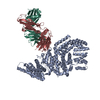 7mnlC 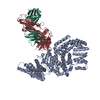 7mnmC 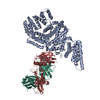 7mnnC 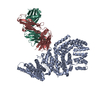 7mnoC 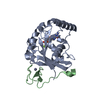 7mnpC 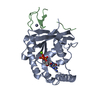 7mnqC 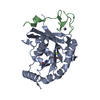 7mnrC 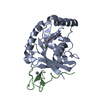 7mnsC 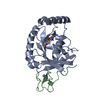 7mntC 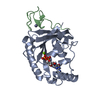 7mnuC 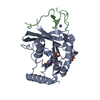 7mnvC  7mnwC 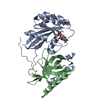 7mnxC 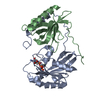 7mnyC  7mnzC 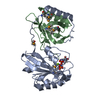 7mo0C 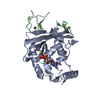 7mo1C  7mo2C 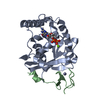 7mo3C 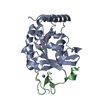 7mo4C 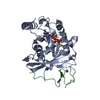 7mo5C 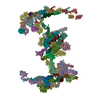 7tblC 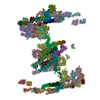 7tbmC C: citing same article ( |
|---|---|
| Similar structure data | Similarity search - Function & homology  F&H Search F&H Search |
- Links
Links
- Assembly
Assembly
| Deposited unit | 
| |||||||||||||||||||||||||||||||||||||||||||||||||||||||||||||||||||||||||||||||||||||||||||||||||||||||||||||||||||||||||||
|---|---|---|---|---|---|---|---|---|---|---|---|---|---|---|---|---|---|---|---|---|---|---|---|---|---|---|---|---|---|---|---|---|---|---|---|---|---|---|---|---|---|---|---|---|---|---|---|---|---|---|---|---|---|---|---|---|---|---|---|---|---|---|---|---|---|---|---|---|---|---|---|---|---|---|---|---|---|---|---|---|---|---|---|---|---|---|---|---|---|---|---|---|---|---|---|---|---|---|---|---|---|---|---|---|---|---|---|---|---|---|---|---|---|---|---|---|---|---|---|---|---|---|---|---|
| 1 | 
| |||||||||||||||||||||||||||||||||||||||||||||||||||||||||||||||||||||||||||||||||||||||||||||||||||||||||||||||||||||||||||
| 2 | 
| |||||||||||||||||||||||||||||||||||||||||||||||||||||||||||||||||||||||||||||||||||||||||||||||||||||||||||||||||||||||||||
| 3 | 
| |||||||||||||||||||||||||||||||||||||||||||||||||||||||||||||||||||||||||||||||||||||||||||||||||||||||||||||||||||||||||||
| Unit cell |
| |||||||||||||||||||||||||||||||||||||||||||||||||||||||||||||||||||||||||||||||||||||||||||||||||||||||||||||||||||||||||||
| Noncrystallographic symmetry (NCS) | NCS domain:
NCS domain segments: Component-ID: 1
|
 Movie
Movie Controller
Controller


 PDBj
PDBj






















